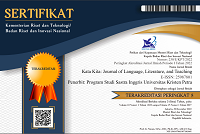Terms of Address Preferences and the Role of Chineseness of Two Chinese Surabayanese
(1) Petra Christian University
(2) Petra Christian University
(*) Corresponding Author
Abstract
This research is conducted to find out the terms of address preferences and the role of Chineseness of two Chinese Surabayanese. What terms of address do the informants of Chinese Indonesians in Surabaya prefer to be addressed at home? Why do they prefer to be addressed that way? How do their terms of address preferences show their Chineseness as Chinese Indonesians? The research used two informants of Surabayanese Chinese Indonesians, one (male) is from the totok family and the other one (female) is from the peranakan family. Qualitative approach combined with semi-structured and open-ended interview are used. Thematic analysis is used to analyze the findings. The findings show that the family’s background played the important role in the terms of address preferences. The one from totok family still maintained Chinese terms of address, while the one from peranakan family had already abandoned the Chinese terms of address.
Keywords
Full Text:
PDFReferences
Chen, Qian (2010). Cultural Differences in Chinese and English Address Terms. Journal of Language Teaching and Research, Vol. 1, No. 6, pp. 898-900, November 2010 © 2010 ACADEMY PUBLISHER Manufactured in Finland.
Dunkling, Leslie (1990). A Dictionary of Epithets and Terms of Address. Taylor & Francis Routledge.
Fitch, Kristine. L. (1998). Speaking relationally: Culture, communication, and interpersonal connection. New York: Guilford.
Hoon, Chang-Yau. (2006). Reconceptualizing ethnic Chinese identity in Post-Suharto Indonesia. Dissertation. The University of Western Australia, School of Social and Cultural Studies, Discipline of Asian Studies. Australia.
Hoon, Chang-Yau and Kuntjara, Esther (2019). The Politics of Mandarin Fever in Contemporary Indonesia. Resinicization, Economic Impetus, and China’s Soft Power. Asian Survey, 59(3), pp. 573-594.
Kuntjara, Esther (2001), Social Research Methods in Feminist’s Perspective: A New Way in Doing Sociolinguistic Qualitative Research. Kata Vol.3 No.1 June 2001. Petra Christian University. Indonesia. DOI: https://doi.org/10.9744/kata.3.1.33-38
Kuntjara, Esther. (2007). The hybrid language of the Chinese in Indonesia: A perspective on language pluralism and the implications in social relationships. In Leo Suryadinata (Ed.) Chinese diaspora since Admiral Zheng He with special reference to maritime Asia. Pp 353-370. Singapore: Chinese Heritage Centre, HuayiNet.
Kuntjara, Esther. (2010). Chinese Indonesian kinship and naming practices. INTISARI Magazine. URL: http://repository.petra.ac.id/id/eprint/15758
Liu, Xuan; Zhang, Lanqin; Zhang, Ying (2010), Study on Addressing Terms and Relevant Culture in America and China. Journal of Language Teaching and Research, Vol. 1, No. 5, pp. 753-756, September 2010. Academic Publisher. Finland.
Ninawati; Setiawan, Kurnia; Suparman, Meiske Yunithree. (2019). Chinese Indonesian Cultural Orientation Analysis. Atlantis Press.
Thung, Ju-Lan. (2000). Susahnya jadi orang Cina: keCinaan sebagai konstruksi sosial. Dalam I. Wibowo (Ed.) Harga yang harus dibayar: Sketsa pergulatan etnis Cina di Indonesia. PT. Gramedia Pustaka Utama. Indonesia.
Turner, John; Oakes, Penny (1986). The significance of the social identity concept for social psychology with reference to individualism, interactionism and social influence. British Journal of Social Psychology. https://doi.org/10.1111/j.2044-8309.1986.tb00732.x
Wardhaugh, Ronald. (2002). An introduction to sociolinguistics. Malden, MA: Blackwell.
Wardhaugh, Ronald; Fuller, Janet M. (2015). An Introduction to Sociolinguistics. Seventh Edition. John Wiley & Sons, Inc. UK.
Wetherell, Margaret; Mohanty, Chandra Talpade. (Eds). (2010). The Sage handbook of identity. Sage Publication.
Yang, Chunli. (2010). Translation of English and Chinese Addressing Terms from the Cultural Aspect. Journal of Language Teaching and Research, Vol. 1, No. 5, pp. 738-742, September 2010 © 2010 ACADEMY PUBLISHER Manufactured in Finland.
DOI: https://doi.org/10.9744/katakita.11.1.67-76
Refbacks
- There are currently no refbacks.
Supported by:
Indexed in:
Tools:
Stats (installed since 17 December 2018)
View My Stats













